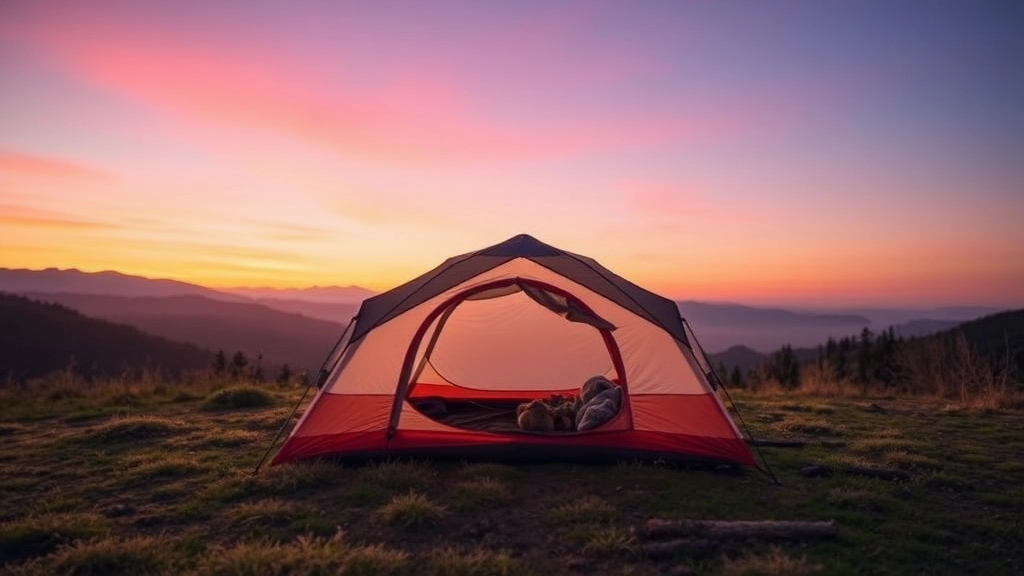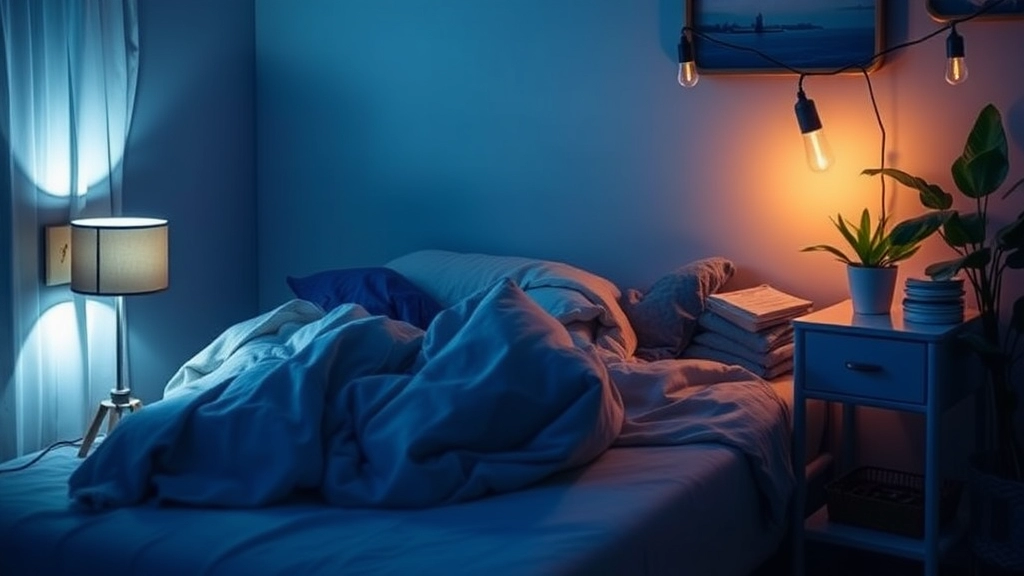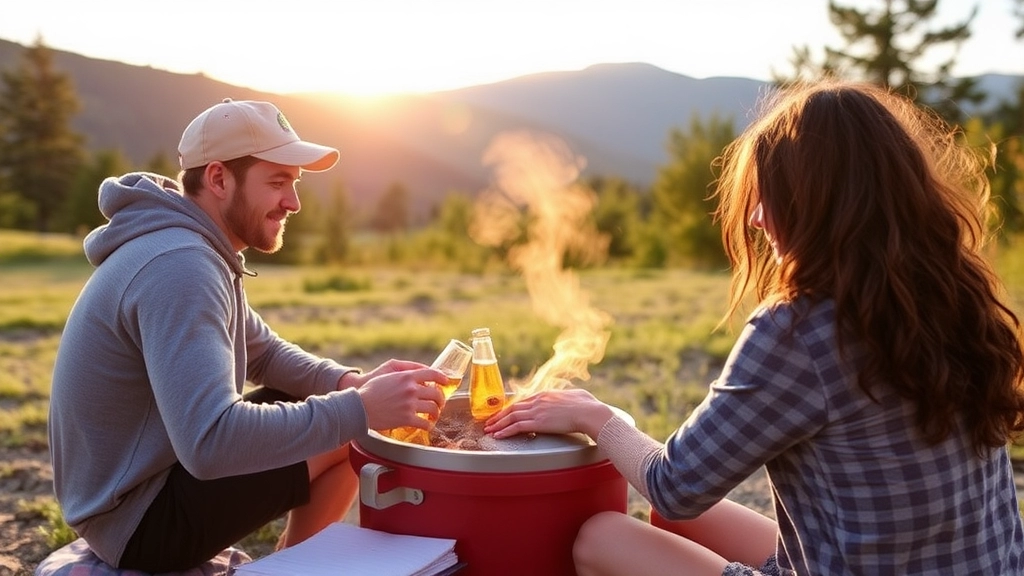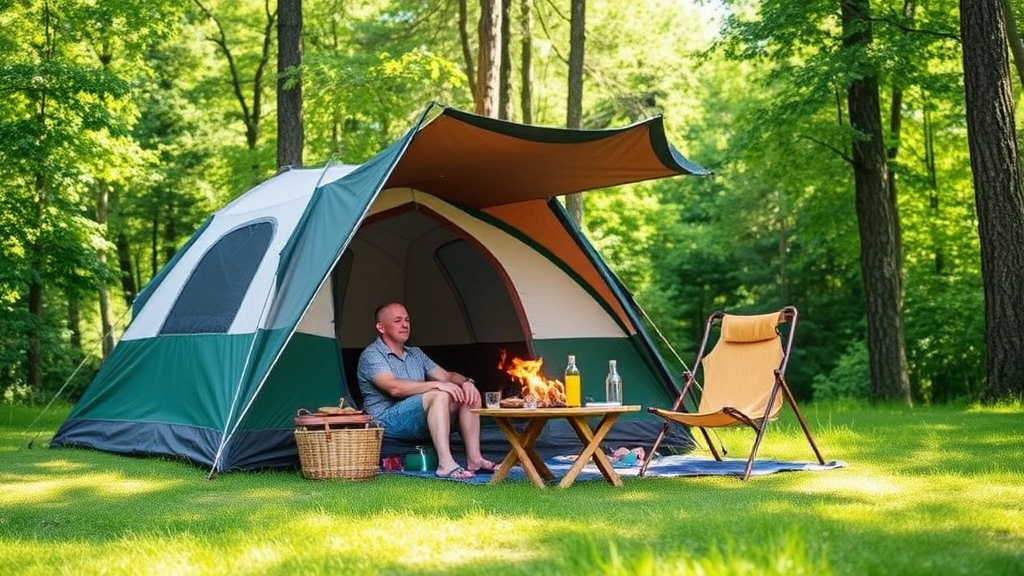Stay Cool Camping in Summer
As the summer sun blazes down, the allure of camping can quickly turn into a sweaty ordeal. But fear not, fellow adventurers! This guide is your ultimate resource on how to stay cool camping in summer. From selecting the perfect campsite to utilizing portable cooling devices, we’ve got you covered with practical tips and real-life examples to ensure your summer camping trip is both enjoyable and refreshing.
We’ll delve into everything from optimizing your tent setup for maximum airflow, using reflective sunshades to block the sun, and staying hydrated with electrolytes, to wearing light, breathable clothing and planning activities around the cooler parts of the day. Whether you’re a seasoned camper or a newbie, these strategies will help you beat the heat and make the most of your outdoor escapades. Ready to stay cool and conquer the summer heat? Let’s dive in!
Choose the Right Campsite for Natural Cooling
Alright, let’s get real for a second. You’re out in the wild, and the last thing you want is to be sweating buckets in your tent. So, how do you pick the perfect campsite to stay cool? Here’s the lowdown.
The Struggle is Real
Ever set up camp and felt like you’re roasting in an oven? Yeah, we’ve all been there. The key is in choosing the right spot. It’s not just about finding a flat surface; it’s about finding a cool, breezy haven.
Location, Location, Location
Find Shade
- Under Trees: Look for a spot under a canopy of trees. They act like nature’s air conditioning, blocking the sun and keeping the ground cooler.
- Near Water: If you can, set up near a lake, river, or stream. The water cools the air around it, making your campsite a bit more bearable.
Elevation Matters
- Higher Ground: Warm air rises, so if you’re in a valley, you’re likely to feel the heat more. Aim for a higher elevation where it’s cooler.
- Avoid Low Spots: These can trap warm air and feel like a sauna.
Orientation is Key
- Face East: Set up your tent facing east. This way, you’ll get the morning sun to wake you up, but avoid the scorching afternoon heat.
Real Talk: Practical Tips
Scout Before You Settle
- Walk Around: Don’t just plop down at the first spot you see. Take a few minutes to walk around and find the best location.
- Check the Ground: Make sure the ground is dry and not damp, as damp ground can lead to a humid environment.
Use Natural Windbreaks
- Rocks and Hills: These can block strong winds but still allow a gentle breeze to flow through your campsite.
- Bushes and Shrubs: They can also act as natural windbreaks, providing some shade and cooling.
Stories from the Trail
I remember this one time, I set up camp right next to a river, under a thick canopy of trees. It was a hot summer day, but the spot I chose was refreshingly cool. The gentle breeze from the river and the shade from the trees made all the difference. Trust me, it’s worth the extra effort to find the right spot.
For more tips on staying cool during your summer adventures, check out our guide on how to stay cool and beat the heat. If you’re planning a trip to Texas, you might also find our list of top summer camping hotspots in Texas helpful.
Set Up Your Tent to Maximize Airflow

Alright, let’s talk airflow.
Ever been in a tent that feels like a sauna? Not fun.
Here’s how to avoid that nightmare.
Choose the Right Spot
First, location is key.
Look for a spot with natural shade, preferably under trees.
Avoid low-lying areas where air can get stagnant.
Tent Orientation
Face the tent door towards the breeze.
No breeze? No problem.
Set up near water sources like lakes or rivers; they usually have a natural airflow.
Ventilation Matters
Make sure your tent has plenty of mesh windows.
Keep them open, especially at night.
Use the rainfly sparingly.
Only use it if there’s rain in the forecast.
Elevate Your Tent
If possible, set your tent on a slight elevation.
This helps air circulate underneath.
Use a Ground Cloth
Place a ground cloth under your tent.
It keeps moisture out and adds a bit of insulation.
Keep the Inside Organized
Less clutter means better airflow.
Keep your gear organized and off the floor.
Real-World Example
I once camped near a river during a heatwave.
Facing the tent door towards the water made a world of difference.
The breeze kept us cool all night.
Quick Tips Recap
- Location: Find natural shade.
- Orientation: Face the door towards the breeze.
- Ventilation: Open those mesh windows.
- Elevation: Set up on a slight rise.
- Ground Cloth: Use it for insulation.
- Organization: Less clutter, more airflow.
Remember, maximizing airflow isn’t just about comfort.
It’s about making your camping experience enjoyable.
Use Reflective Sunshades to Block Sunlight
Ever found yourself roasting in your tent like a Sunday chicken? Yeah, me too. Here’s a game-changer: reflective sunshades. These bad boys can be a lifesaver when you’re out camping, keeping your tent cool and comfortable. Let’s break it down.
Why Reflective Sunshades?
First off, why even bother with reflective sunshades? Simple. They bounce the sun’s rays away, preventing your tent from turning into a sauna. Think of it as giving your tent a shiny, protective shield.
How to Use Reflective Sunshades
Now, let’s get into the nitty-gritty. How do you use these sunshades effectively? Here’s a quick guide:
- Placement is Key: Position your sunshade above your tent. Use trees, poles, or any sturdy structure to drape it over. Make sure there’s a gap between the sunshade and your tent for air to flow through.
- Angle Matters: Aim to angle the sunshade so it catches the sun’s rays directly. This maximizes the reflective surface area.
- Secure It Well: Use ropes or bungee cords to keep the sunshade in place. The last thing you want is for it to blow away with a gust of wind.
- Double Up If Needed: In scorching conditions, consider using two layers of reflective material. More reflection equals more cooling.
Types of Reflective Sunshades
Not all sunshades are created equal. Here are a few options to consider:
- Emergency Blankets: Affordable and effective. These are great in a pinch.
- Reflective Tarps: More durable and can cover larger areas.
- Custom Reflective Covers: Tailored to fit your tent, offering maximum efficiency.
Real-World Example
I remember last summer, camping in the Lake District. The sun was relentless. I rigged up a reflective tarp above my tent, and it was like night and day. While my mates were sweating buckets, I was chilling in a cool, shaded haven. Trust me, it makes a huge difference.
Additional Tips
- Combine with Natural Shade: If possible, set up your tent under trees and use the reflective sunshade for double the cooling effect.
- Portable Fans: Pair your sunshade with a portable fan to circulate air and keep things even cooler.
- Hydrate: Staying cool isn’t just about your tent. Keep yourself hydrated to help your body regulate temperature.
For more tips on staying comfortable during your camping adventures, check out our guide on summer tent camping. And if you’re planning a trip to a popular destination, don’t miss our list of the top summer camps in Albuquerque.
Optimize Your Sleep Setup for Cooler Nights

Struggling to sleep when camping in hot weather?
I get it.
It’s tough to catch those Z’s when you’re sweating buckets.
But don’t worry, I’ve got you covered.
Here’s how to optimize your sleep setup for cooler nights.
Choose the Right Sleeping Bag
Not all sleeping bags are created equal.
Go for a lightweight, breathable one.
Pro Tip: Look for sleeping bags rated for summer use. They’re designed to keep you cool.
Use a Sleeping Pad
A sleeping pad does more than just add comfort.
It also creates a barrier between you and the hot ground.
Bonus: Some sleeping pads are designed to reflect heat away from you.
Ventilate Your Tent
Good airflow is crucial.
- Open all windows and vents.
- Use mesh panels if your tent has them.
Position Your Tent Wisely
Where you set up your tent matters.
- Avoid direct sunlight.
- Opt for shaded areas.
- Face your tent door towards the breeze.
Ditch the Heavy Bedding
Heavy blankets are a no-go.
Stick to light sheets and breathable fabrics.
Pro Tip: Moisture-wicking materials work wonders.
Try a Cooling Pillow
Yes, they exist!
A cooling pillow can make a world of difference.
Stay Hydrated
Hydration isn’t just for daytime.
A well-hydrated body stays cooler at night.
Quick Tip: Keep a water bottle handy.
Use a Portable Fan
A small, battery-operated fan can be a game-changer.
Place it near your sleeping area for a cool breeze.
Sleep in Minimal Clothing
Less is more when it comes to sleepwear.
Choose light, breathable fabrics.
Take a Cool Shower Before Bed
A quick rinse can lower your body temperature.
Trust me, it helps.
Utilize Portable Cooling Devices
Ever been camping in the summer and felt like you were sleeping in an oven? Yeah, me too. That’s where portable cooling devices come in. They can be game-changers for keeping your tent cool and your sanity intact.
Why Portable Cooling Devices?
First off, let’s address the big question: Why bother with portable cooling devices? Well, they can make the difference between a sleepless, sweaty night and a restful, refreshing one. Trust me, you don’t want to wake up drenched in sweat with the sun barely up.
Types of Portable Cooling Devices
There are a few options out there, and each has its own set of pros and cons. Here’s a quick rundown:
- Battery-Powered Fans: These are lightweight and easy to pack. Plus, they circulate air effectively.
- Portable Air Conditioners: A bit bulkier and pricier, but they can cool your tent down significantly.
- Evaporative Coolers: These work best in dry climates and can lower the temperature by a few degrees.
How to Use Them Effectively
Now, just having a cooling device isn’t enough. You need to use it the right way. Here’s how:
- Positioning: Place your fan or cooler at the tent entrance to pull in cooler air from outside.
- Timing: Run your cooling device during the hottest part of the day and switch it off at night to save battery.
- Maintenance: Keep your devices clean and make sure they’re fully charged before you head out.
Real-Life Example
I remember one camping trip where my buddy brought a battery-powered fan. At first, I thought he was being extra. But when the temperature soared to 35°C, that fan was a lifesaver. We positioned it right at the tent’s entrance, and it made a world of difference.
Internal Linking Opportunity
For more tips on staying cool while camping, check out our section on Essential Tips for Staying Cool While Camping.
Portable cooling devices can be your best friend on a hot camping trip. Trust me, once you try them, you won’t want to go back to sweating it out. So, pack smart, stay cool, and enjoy the great outdoors!
For a comprehensive guide on fun and safe summer camp experiences, visit our KSC Summer Camp Guide.
Stay Hydrated and Balanced with Electrolytes

Ever felt like a wilted flower under the sun?
Yeah, me too.
When you’re out camping, staying hydrated isn’t just a nice-to-have—it’s crucial.
Water is your best mate, but sometimes, you need more than just H2O.
Why? Because when you’re sweating buckets, you’re also losing electrolytes.
And without those, you might feel like a zombie.
So, what’s the game plan?
1. Drink Water Regularly
Don’t wait until you’re parched.
Sip water throughout the day.
Pro tip: Keep a water bottle handy at all times.
2. Add Electrolytes
Water’s great, but it doesn’t replace lost electrolytes.
Options:
- Electrolyte tablets: Easy to carry and use.
- Sports drinks: Convenient but watch the sugar.
- DIY electrolyte mix: A pinch of salt, a squeeze of lemon, and a bit of honey in your water.
3. Eat Hydrating Foods
Fruits and veggies can help keep you hydrated.
Top picks:
- Cucumbers
- Watermelon
- Oranges
4. Monitor Your Hydration
Check your pee.
Seriously.
If it’s dark yellow, you need more fluids.
5. Balance Electrolytes
Too much water without electrolytes can mess you up.
Signs you need electrolytes:
- Muscle cramps
- Fatigue
- Dizziness
6. Avoid Alcohol and Caffeine
These can dehydrate you faster.
Stick to water and electrolyte drinks.
Real Talk
Ever felt dizzy and weak on a camping trip?
That’s dehydration kicking in.
Don’t let it ruin your adventure.
Stay hydrated, balanced, and enjoy your time outdoors.
Wear Light, Breathable Clothing
Struggling to keep cool while camping? You’re not alone. When the sun’s blazing, the last thing you want is to feel like you’re trapped in a sauna. The key here is simple: wear light, breathable clothing.
Why Light, Breathable Clothing Matters
Ever felt like your clothes are suffocating you? Heavy, non-breathable fabrics trap heat and sweat, making you uncomfortable and irritable. We’ve all been there, right? Here’s how to avoid that:
- Choose the Right Fabrics: Go for natural fibres like cotton or linen. These materials allow air to circulate, helping you stay cool.
- Opt for Loose Fits: Tight clothing restricts airflow. Loose fits let your skin breathe.
- Light Colours: Dark colours absorb heat. Stick to whites, pastels, and other light shades to reflect sunlight.
Real Talk: What I Wear on a Scorching Day
When I’m out camping in the heat, I live in my light, airy cotton t-shirts and cargo shorts. They’re comfy, they breathe, and they don’t stick to me like glue. I avoid synthetic materials like the plague because they just don’t cut it when it comes to staying cool.
Practical Tips for Choosing the Right Camping Gear
- Hats: A wide-brimmed hat can be a lifesaver. It keeps the sun off your face and neck.
- Footwear: Go for breathable shoes or sandals. Your feet need to stay cool too.
- Layer Up: Yes, layers! Even in the heat, having a light, long-sleeved shirt can protect you from the sun and bugs. Just make sure it’s breathable.
Quick Checklist for Your Camping Wardrobe
- Cotton t-shirts
- Linen shirts
- Cargo shorts
- Lightweight trousers
- Wide-brimmed hat
- Breathable sandals
The Science Behind It
Here’s a bit of science to back it up: breathable fabrics wick moisture away from your skin, allowing it to evaporate and cool you down. It’s like having a built-in air conditioning system.
For more tips on making your summer camp experience enjoyable, check out our Ultimate Packing Guide. Also, if you’re looking for fun activities to do while camping, don’t miss our Drawing Fun and Creative Ideas.
Plan Activities Around Cooler Parts of the Day

Ever felt like you’re melting under the blazing sun while camping? Yeah, me too. Let’s fix that.
Why it Matters
You want to enjoy your trip, not roast like a marshmallow. Planning activities during cooler parts of the day is a game-changer. Trust me, it’s the difference between having fun and feeling like you’re in a sauna.
Early Morning and Late Afternoon: Your Best Friends
The early bird gets the worm—and stays cool. Here’s why:
- Morning Chill: The air is cooler, and the sun isn’t at full blast.
- Late Afternoon: The sun starts to dip, giving you a break from the heat.
What Activities to Do When
- Morning: Perfect for hikes, exploring, and setting up camp.
- Midday: Chill out. Seriously, find some shade, read a book, or take a nap.
- Evening: Ideal for cooking, socialising, and light activities.
Real Talk: My Experience
Last summer, I planned a midday hike. Big mistake. I was sweating buckets, and my energy was zapped. Lesson learned. Now, I always hit the trails early and save the chill time for when the sun’s high.
Quick Tips
- Check the Weather: Use apps to see when it’ll be hottest.
- Adjust Your Schedule: Be flexible. Move activities around based on the temperature.
- Stay Hydrated: Keep water handy. Always.
Want more tips on staying cool while camping? Check out our guides on choosing the right campsite and using portable cooling devices.
Stay cool out there!
Take Advantage of Water Sources
Ever been camping in the sweltering heat and thought, “How am I going to stay cool out here?” Well, one of the best ways to beat the heat is to take advantage of nearby water sources. Trust me, it’s a game-changer.
Why Water Sources Are Your Best Friend
When you’re out in the wild, nothing cools you down faster than water. Whether it’s a lake, river, or even a small stream, being close to water can make your camping experience a lot more comfortable. Plus, it’s a natural way to regulate your body temperature without any fancy gadgets.
How to Make the Most of Water Sources
- Swim Often:
- Morning Dips: Start your day with a refreshing swim. It wakes you up and cools you down.
- Afternoon Breaks: The sun is at its peak, and you’re probably feeling the heat. Take a mid-day swim to lower your body temperature.
- Evening Chill: Before you hit the sack, a quick dip can help you sleep cooler.
- Use Wet Clothing:
- Wet Bandanas: Drape a wet bandana around your neck. It’s like your own personal air conditioner.
- Damp Shirts: Wear a damp shirt to keep cool. The evaporation process will help lower your body temperature.
- Create a Splash Zone:
- Portable Showers: If you’re near a water source, set up a portable shower. It’s an easy way to rinse off the sweat and grime.
- Water Fights: Get everyone involved in a good old-fashioned water fight. It’s fun and effective for cooling down.
- Stay Hydrated:
- Drink Plenty: Always have a bottle of water with you. Staying hydrated helps your body cope with the heat.
- Electrolytes: Add electrolyte tablets to your water to replenish what you lose through sweat.
Real Talk: My Own Experience
I remember one camping trip where the heat was unbearable. We were next to a river, and I thought, “Why not take advantage of it?” We spent the day swimming, splashing around, and using wet bandanas to stay cool. It turned what could have been a miserable experience into one of the best camping trips I’ve ever had.
Bonus Tips
- Fishing: If you’re into fishing, it’s a great way to stay near the water and keep cool.
- Kayaking or Canoeing: These activities not only keep you cool but also add an element of adventure to your trip.
For more tips on staying cool and having fun, check out our Summer Camp Water Games and discover Top Summer Camp Games and Activities to make your camping experience unforgettable.
Create a Comfortable Sleeping Environment
Ever tried to sleep in a tent that’s hotter than a sauna?
Yeah, not fun.
Creating a comfortable sleeping environment is key to staying cool while camping.
And trust me, it’s easier than you think.
Why Is It So Hard to Sleep Cool While Camping?
You’ve picked the perfect campsite, but the heat’s still unbearable.
Why?
Because your sleeping setup might be all wrong.
Here’s how to fix it:
- Use a Sleeping Pad: Insulates you from the hot ground.
- Choose a Light Sleeping Bag: Opt for one designed for warm weather.
- Ventilate Your Tent: Keep the windows open for airflow.
The Right Gear for Cool Nights
Not all sleeping bags are created equal.
Get one that’s lightweight and breathable.
Avoid heavy, insulated bags meant for winter.
Position Matters
Where you place your tent can make a huge difference.
- Elevate Your Tent: If possible, set it up on a slight incline.
- Avoid Low Spots: Cold air settles in low areas at night.
Real-Life Example
I once camped in the desert.
Thought I was prepared.
But my heavy-duty sleeping bag turned my tent into an oven.
Switched to a light, breathable bag the next night.
Made all the difference.
Quick Tips for a Cool Sleep Setup
- Use a Reflective Blanket: Place it under your sleeping pad. Reflects heat away.
- Pack a Portable Fan: Battery-operated fans can be lifesavers.
- Cool Down Before Bed: Take a dip in a nearby stream or use a wet cloth to wipe down.
For more tips on staying cool, check out our essential summer camping tips and make sure your next adventure is comfortable and enjoyable.
Don’t forget to explore our guide on summer camp essentials to ensure you have everything you need for a successful trip.
FAQs on How to Stay Cool While Camping in Summer
How can I set up my tent to maximize airflow?
To maximize airflow, choose a spot with natural shade, preferably under trees, and avoid low-lying areas where air can get stagnant. Face the tent door towards the breeze or set up near water sources like lakes or rivers. Make sure your tent has plenty of mesh windows and keep them open, especially at night. Use the rainfly sparingly, only if there’s rain in the forecast.
What are the best tips for keeping my tent cool?
Set your tent on a slight elevation to help air circulate underneath. Use a ground cloth to keep moisture out and add insulation. Keep the inside of your tent organized to allow for better airflow. Less clutter means more room for air to move around.
How should I optimize my sleep setup for cooler nights?
Use a lightweight, breathable sleeping bag rated for summer use. A sleeping pad can create a barrier between you and the hot ground, and some are designed to reflect heat away from you. Open all windows and vents in your tent and use mesh panels if available. Avoid direct sunlight and opt for shaded areas when setting up your tent.
What kind of bedding should I use for hot weather camping?
Ditch the heavy blankets and stick to light sheets made of breathable, moisture-wicking fabrics. Consider using a cooling pillow to help regulate your body temperature.
How can I stay hydrated while camping in hot weather?
Drink water regularly and don’t wait until you’re thirsty. Add electrolytes to your water through tablets, sports drinks, or a DIY mix of salt, lemon, and honey. Eat hydrating foods like cucumbers, watermelon, and oranges. Monitor your hydration by checking the color of your urine; dark yellow indicates you need more fluids.
What are the signs that I need more electrolytes?
Signs that you need more electrolytes include muscle cramps, fatigue, and dizziness. Balance your water intake with electrolyte-rich drinks to avoid these symptoms.
When is the best time to plan activities to avoid the heat?
The best times for activities are early morning and late afternoon when the air is cooler and the sun isn’t as intense. Avoid strenuous activities during midday when the sun is at its peak. Use this time to relax in the shade or take a nap.
What should I do if I feel dehydrated or overheated?
If you feel dehydrated or overheated, take immediate steps to cool down. Move to a shaded area, drink water with added electrolytes, and rest. If symptoms persist, seek medical attention.
Are there any portable cooling devices that can help?
Yes, a small, battery-operated fan can be a game-changer. Place it near your sleeping area for a cool breeze. Additionally, taking a cool shower before bed can help lower your body temperature.
For more detailed tips and guides, check out our sections on choosing the right campsite and using portable cooling devices.
Stay cool and enjoy your camping adventure!
References
-
REI: Camping in Hot Weather Tips
-
Outdoor Life: How to Stay Cool While Camping
-
CleverHiker: Staying Cool While Camping

